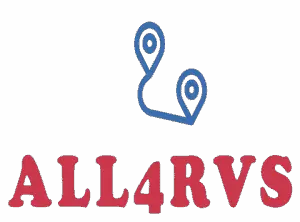Non-RVers or newbie RVers may have never thought of 2-way radios as essential for travelling. But when you enter the RV world, you get to realise that it actually is essential. Why? You’ll know as you read through. More importantly, there are so many types of such radios. So, browse to see everything you need to know about 2-way radios as an RVer and not as an expert – if you know what I mean.
Try looking up “the best 2-way radios in Australia” on the web. Are you not overwhelmed by the sudden flash of jargon like UHF, VHF, CB radio, and a lot more alphanumeric code combinations? Cheer up! Because this is the ultimate guide you definitely won’t regret reading, since I’m going to explain 2-way radios here from scratch.
BLOG CONTENTS
Why does every RVer need a 2-way radios?
What are 2-way radios and how do they work?
Which radio is the best for RVing?
What alternatives are there to 2-way radios?
Summary on what every RVer needs to know about 2-way radios
Why does every RVer need a 2-way radios?
Before straining you into understanding the concept of 2-way radios, knowing why you need them is more important.

Photo by cottonbro from Pexels
For safety and emergency purposes
As an RVer, it’s inevitable to go on outback areas. Okay, let’s say even if not outback, there will always be areas where mobile phone and internet signals do not reach.
Although peaceful secluded areas are good locations to restore your sanity, you should not neglect safety.
No one knows what may happen to you – be it from the sudden slightest inconvenience to the worst emergency. So it’s better to be a step ahead.
Also, if you’re with family, it’s just impossible to stop your kids (or spouse) from exploring the area. And sometimes they go too far. But if they bring with them a 2-way radio, you’ll be able to look for them minus the panic and stress.
On the other hand, if you’re on solo travel and some emergency happened – just turn your 2-way radio on and reach out for help. Emergency responders will surely be able to receive your signal no matter which corner of Australia you are in.
Communicating with other road users
This is one use that people usually undermine, thinking that it’s only for police officers, medical personnel and emergency responders. The truth is, RVers need to communicate with other road users via 2-way radio from time to time. This holds especially in the following cases:
RVers may need to communicate with truck drivers in shared rest areas. In what circumstances?
- You’ll never want a truck suddenly swooshing by your RV, coz the tendency is that your RV will sway.
- In another case, you may want to overtake a truck. So might as well do it safely by informing the truckie that you’re going to overtake. In return, the truckie will advise you whether or not it’s safe to pass by.
The case is the same with drivers of other vehicles. Notifying them that you’re going to overtake, or when you notice that something’s wrong with their vehicle (flat tyre, loose tow coupling, etc.), is a big help to avoid accidents. Same for one-way or narrow passages like bridges and mountain trails.
“Other road users” also include people on the road – for example, road workers. In the midst of traffic congestion due to road repairs, you may communicate with them to know what’s going on and timely decide how to shift your schedule.
Travel buddies are of course included in the loop. When you travel as a pack of RVers, you need to keep your company in check. That’s when a 2-way radio does its job.
Are you now convinced enough that 2-way radios are essential? Then let’s head on to “2-way radio 101”.
What are 2-way radios and how do they work?
Probably a walkie talkie is the best example you can relate with in terms of 2-way radios. So from there, you can well understand that 2-way radios are not like AM or FM radios where you can only receive broadcasted content (e.g. news, music etc.).
Two-way radios are devices that allow you to both receive and send information via radio waves. That is why they are also called “transceivers”.
And NO – not all 2-way radios are walkie talkies. To start, it is best to get to know 2-way radios deeper (and clearer) if you understand that there are many ways how they work. So we should categorise them into this simple matrix to catch a bird’s eye view:

If you observe the above matrix, you can see in the centre the licence category. Before even knowing what type of device you may use, know your qualification first. After having settled that, you may now explore the other categories.
Alright. We have a lot to discuss, so hang in there!
Radios and frequencies – How do they relate?
To be able to understand the difference between radio types under each category, you must know how radios and frequencies relate. It’s like getting to know first what the internet is all about before understanding how Netflix works.
Electromagnetic (EM) waves are present all around us. Think of them as tiny particles suspended in the air. And because they’re tiny enough, they’re invisible to the naked eye – but they do exist; they even freely travel everywhere!
And yes, for now, you can think of these electromagnetic waves as in the form of:
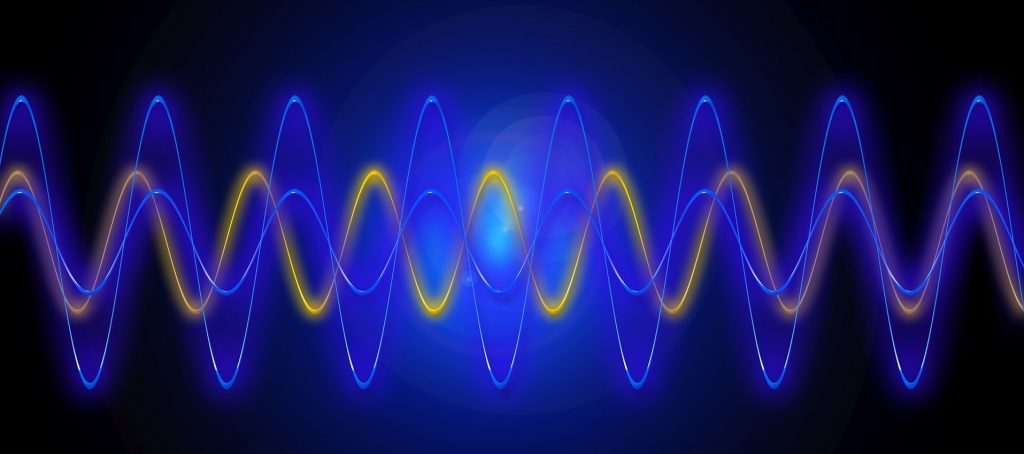
Now these EM waves do not travel at the same speed. That is why there is the term “frequency” to categorise the types of EM waves based on how fast they travel.
Frequency is the measure of how fast a wave travels. The most common unit of measurement for frequency is Hertz (Hz).
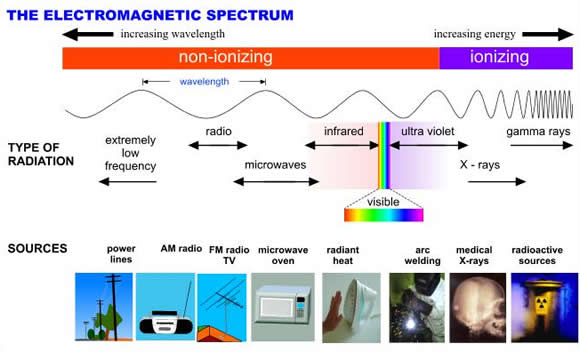
Source: Australian Radiation Protection and Nuclear Safety Agency (ARPANSA)
To simplify this discussion, refer to the image above. You can well see that EM waves are so broad that it has so many categories – one of which are radio waves which we’ll be focusing on.
Radio waves have a frequency range of 3kHz to 300GHz. Therefore, all radio (or radio-like) devices (e.g. stereo, 2-way radio, mobile phone, etc.) operate within that frequency range. Refer to ACMA’s spectrum allocation chart to see a more detailed breakdown.
Depending on the type that you buy or rent, your 2-way radio may have a specific frequency that’s dedicated to itself only. Otherwise, you may use public frequencies or channels which are shared among other radio users. It’s more like having a VPN versus connecting over a hotspot or Wi-Fi. We’ll tackle more on this later.
Communication mode category
As introduced, 2-way radios can both receive and send information. However, that’s in three modes.
1. Simplex Mode
In simplex mode, your device’s transmitter will send radio waves DIRECTLY to the device of the receiver. Therefore, only one party can talk at a time. The only requirement here is that your device’s radio frequency must be the same as that of whom you’re talking to.
Remember FM stations? They are almost always named with numbers attached to them. That is because those numbers indicate the frequency at which you must tune in so you can listen to that particular FM station. So for example, you wanted to listen to KIIS 101.1 FM. What you do is turn on your stereo, control the knob until you find “101.1” in your display. That means you are adjusting your stereo’s frequency until it matches the FM station’s frequency which is 101.1 MHz (megahertz).
That’s the same with simplex mode. Before you can listen and talk to the other party, you must set your devices so that they’re on the same exact frequency.
2. Duplex Mode
Duplex mode, on the other hand, lets you communicate with the receiver NOT directly, but with a device (“third-party transmitter”) mediating in between. This device is the large antenna or “Eiffel Towers” you see everywhere.

In this mode, you and the other party will be able to communicate even if you’re on different frequencies. That is because your mediator (the large antenna) does the converting for you. In other terms, the transmitter:
-
-
- Receives your message at your frequency,
- Converts it so that it becomes compatible with the receiver’s frequency, and then
- Passes on that message to the receiver.
-
What an awesome mediator, isn’t it? Also, these large antennas may have “repeaters” integrated into them.
A repeater receives your device’s radio signal and amplifies it so that your message can be received from a distance much farther than when using your radio alone.
In simpler terms, it’s like a megaphone that amplifies your voice so it can be heard from a farther distance. It’s great if your device’s frequency band is low. But the downside here is that since it’s like a megaphone, your voice will be heard not only by your intended receiver but also by other radio users.
Note that repeaters may come in a stand-alone portable device as well. So you may consider purchasing this as additional later on when you’ve familiarised yourself with the entry-level 2-way radio type.
3. Half-duplex Mode
Lastly, the half-duplex mode is understandably a combination of the simplex and duplex modes. Only one party can talk at a time, and it needs a third-party transmitter. This is where our walkie talkie example becomes useful again. A walkie talkie is an example of a 2-way radio that communicates on half-duplex mode. Before being able to speak, you have to push a certain button first – hence the more general term “push-to-talk (PTT) radio”.
Frequency band category
I have already explained how radios and frequencies relate, so tackling this category a bit further will now be a piece of cake for you.
Concept
To choose the frequency that’s appropriate for your intended use, you must familiarise yourself with how high frequencies and low frequencies differ.
Higher frequencies travel faster while lower frequencies resonate longer.
High frequency equals high pitch. Compare the sound produced when you strum a bass guitar versus an electric guitar. It may not be that obvious, but you will hear the bass guitar’s sound linger for a while longer than would an electric guitar. Or to exaggerate – try to remember the sound of the Big Ben versus the sound of a xylophone’s high pitch.
Are you getting now the difference in the travel speeds between high and low frequencies? Now let’s move on to the matter of penetration.
Radio waves in general cannot penetrate through conducting materials such as metals and water.
Even if lower frequencies are said to have better penetration than higher frequencies, it mainly depends on the wavelength. If you look back at the ARPANSA image above, the wavelength is characterised as the width of the radio wave. Practically, you can say that it’s the “size” of the wave.
So let’s take your RV as an example. Your RV has metal walls and an 850mm door. With your RV door open, a low-frequency radio wave with a wavelength (“size”) of 10m obviously cannot pass through. But a high-frequency wave with a wavelength of 500mm can easily pass through.
Now to finally relate these two jargons (frequency and wavelength) into 2-way radios…
Application
We saw earlier how broad the electromagnetic spectrum is. And looking at the range of radio frequencies (3kHz to 300GHz) – it’s still so broad! So, even radio frequencies are subdivided into UHF, VHF and HF. There are still other subdivisions, but those three are the most common in 2-way radios. I’m considerate enough to not cause you a headache due to unnecessary information.
Without further ado, here are your 2-way radio options in terms of frequency band:
| RADIO TYPE | FREQUENCY RANGE | WAVELENGTH RANGE |
| Ultra-high frequency (UHF) radio | 300MHz to 3GHz | 0.1 to 1m |
| Very high frequency (VHF) radio | 30MHz to 300MHz | 1m to 10m |
| High frequency (HF) radio | 3MHz to 30MHz | 10m to 100m |
Now, what does that table say about 2-way radios?
RVers who frequently travel within cities and dense forests are advisable to use UHF radios. Because UHF radio waves are “smaller”, they can navigate better in between small openings like doors, hallways, and within thick forests.
On the flipside, RVers who frequently travel to open areas (e.g. outback, seasides, etc.) are advised to use VHF radios whose radio waves travel at a greater distance.
This is quite a tough choice if you travel both kinds of areas. Don’t worry, we’re still scratching just the tip of the iceberg. There are other determining factors yet to consider, so be sure to finish this blog.
Oh, and don’t mind HF radios for now as they’re recommended for users who are familiarised with entry level 2-way radios.
Licence category
Expect things to get even more interesting from here.
Australia has three main licence types for users of radiocommunications devices – yes, that’s including 2-way radios.
Say what? Does that mean RVers need to acquire some sort of licence? The answer is “not necessarily”. The Australian Communications and Media Authority (ACMA) governs all licences related to radio communications. Note that each licence mentioned below have links on them. So in case you’re interested in a particular licence, click on the link to know the legalities that come with it. Anyhow, ACMA mainly categorise such licences into:
1. Class Licences
A class licence lets you operate common radio equipment on shared frequencies. This is where your 2-way radio and mobile phone come in. So, NO – you neither need to acquire proof nor pay any fees to say that you are under a class licence. (Just as you don’t need any licence to use a mobile phone)
It may be confusing as to why is there a need to categorise this as a licence type when no actual licence is issued. But consider it just a formality.
Class licences have 15 types but the only ones relevant to RVers are:
a. Citizen band (CB) radio station class licence
This is the default 2-way radio for the general public. As such, the frequencies here are shared at:
-
-
- HF – 26.965 MHz to 27.405 MHz (for marine only; therefore, not applicable to RVers)
- UHF – 476.4125 to 477.4125 MHz
-
Just like TV programs, UHF CB radios have (80) channels for users to tune in. According to the Radiocommunications (Citizen Band Radio Stations) Class Licence 2015 document, these are the channels allowable for UHF CB radio users:
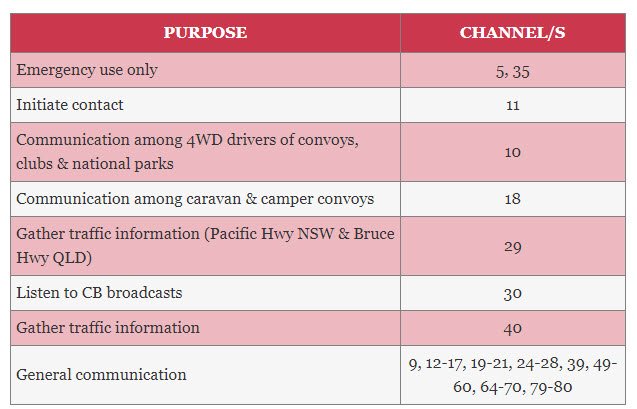
Tuning in to any channel not included in the above list could get you in trouble because you are interfering with others’ signals. For more information on the usage terms for CB radios, check out the legislation referenced earlier.
b. 27MHz handphone stations class licence
Although applicable to entry level radio users too (particularly for bushwalkers), 27MHz handphone stations generally allow communications ranging up to 1km only.
c. Overseas amateur visiting Australia
Radio-licenced foreigners are permitted to operate for up to 90 days starting from the date of arrival. More importantly, the devices, frequency bands and power output limits you are allowed to operate under must comply with both the scope of the foreigner’s licence and the terms of ACMA.
Beware! Not all imported 2-way radios are allowed for use in Australia. Visit the ACMA regulations for more information.
2. Apparatus Licences
An apparatus licence allows you to operate transmitters and/or receivers at a specific place and frequency range. You can well compare it to a Youtube premium subscription where you can get access to content that are not available for free users, while still being limited to content that is allowed in your country.
3. Spectrum Licences
You may call the spectrum licence the “VIP of radiocommunications licences”. That is because the frequencies assigned to it are extremely rare, and its validity is up to 15 years! And because they’re rare, spectrum licences are sold only via auction, tender, set price, or negotiation.
In any case, if you want to know more about the other licences, you may find my Radio Licences for RVers blog useful. That post discusses in more detail other licences for RVers.
Form category
In simplest terms, RVers can initially choose only from portable and vehicle mount radios. That is because base stations for radio are large, heavy, and not operable under a class licence. You can usually see base stations in movie scenes wherein an agent is inside the cabin of a van full of technical equipment, communicating with his/her comrades.
The easiest way to start with is of course with portables. Although their range is shorter than the vehicle mount, it beats the latter in terms of functionality. For example, for safety and emergency purposes you may let your spouse or kids take a portable radio with them while they explore the site.
While they have greater range and better signal, vehicle mount 2-way radios are not automatically installed in every RV, so you’ll have to retrofit them in case you want this radio type.
Display category
I’m sure you already know or at least have an idea of the main difference between analog and digital devices. But to relate it further to two-way radios,
Analog 2-way radios are good for only short distances and quick communications. Oppositely, digital 2-way radios have better quality communication, plus additional features such as Bluetooth connectivity (typically for headphones) and GPS among many others.
Which radio is the best for RVing?
Now here’s the climax – which is best for RVing? The short answer is: it depends on your priority and travel preferences. Let’s face it, each has its own pros and cons. But let’s go back to our matrix:

Naturally, what you will find in the market are a mix and match of all the types above. But to simplify things, start with the bare minimum – a portable simplex UHF CB radio. It doesn’t really matter if it’s analog or digital, but to decide how to take the specs a notch higher – here’s a guide:
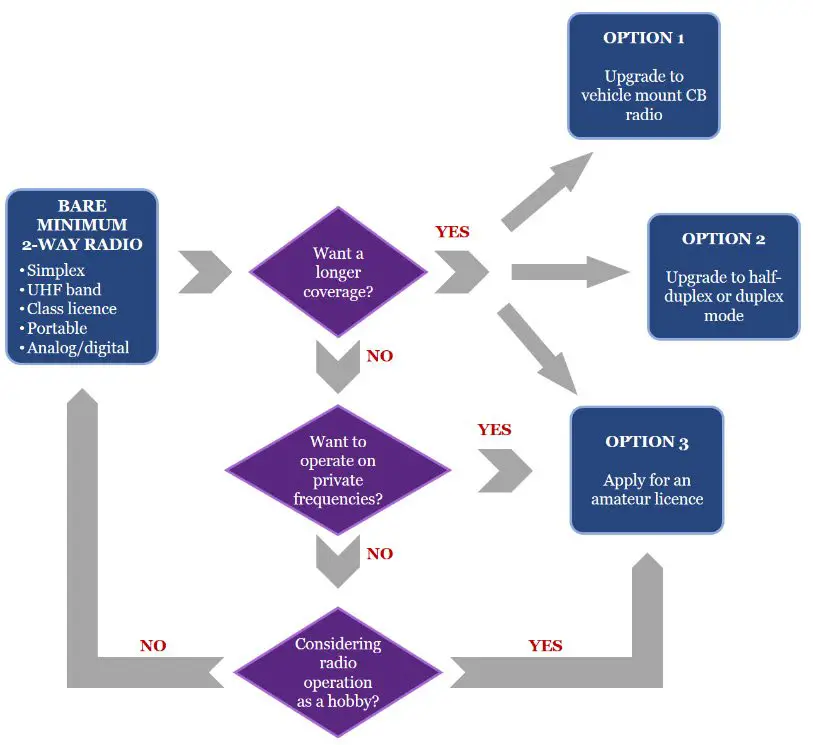
What alternatives are there to 2-way radios?
Obviously, 2-way radios aren’t the only option to go. There are many good alternatives under class licences, some of which include:
- Satellite phones
- Cordless phones that use DECT
- Personal handy phone systems
- Devices that use CT2 and CT3
- Royal Flying Doctor radios
- A few locating devices
Summary on what every RVer needs to know about 2-way radios
After all, that’s been said here, it’s painstaking to repeat details. So I’ll leave you instead with key points to consider before buying a 2-way radio.
- Are you using it for the first time? If so, go with the bare minimum (UHF CB handheld radios) regardless if you frequently travel to cities or suburbs or both.
- Do you see yourself taking interest in this activity? Or do you plan to operate a transmitter or receiver aside from a 2-way radio? If so, apply for the most basic amateur radio licence – the Foundation licence.
- Are you an amateur radio-licenced foreigner who’s on vacation to Australia? Then you may operate 2-way radios in the country for up to 90 days starting from your date of arrival.
From there you can figure it out on your own and the rest is a matter of preference. Again, I recommend you to know as well other Radio Licences for RVers in Australia. Who knows, you might become one of Australia’s few profound radio operators.
